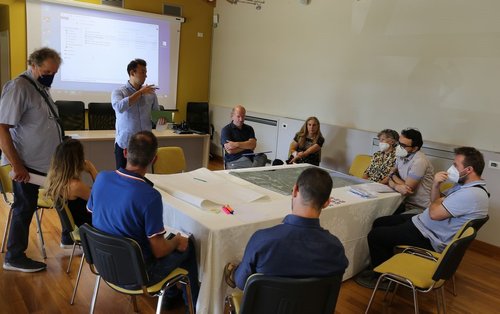The first full-day workshop of the Isonzo/Soča transboundary river basin REXUS project pilot took place on 14 of July 2022, bringing together almost 40 participants from across the Water-Energy-Food Nexus from both Italy and Slovenia, to identify and discuss environmental, economic and social challenges, and potential solutions. The workshop, organized by REXUS Isonzo/Soča pilot leader, AAWA, was hosted by the ‘Consorzio di Bonifica della Venezia Giulia’, the soil reclamation Consortium from the eastern part of the Region, in Ronchi dei Legionari (GO), Italy, with the support and participation of members of AAWA, UCLM, AGRISAT, CNR-IRSA, UNIPD and ETIFOR on behalf of the REXUS Consortium.


Picking up from the Isonzo/Soča pilot kick-off meeting of March 3rd 2022, the workshop introduced stakeholders, in a dynamic and interactive way, to the preliminary results of the REXUS scientific tools and models used for quantifying the WEF Nexus issues and interconnections in the basin. True to the REXUS project’s strong emphasis on participatory planning, the workshop kicked of with ‘Pro-action Café’ session, with participants walking around four thematic stations and offering their feedback, validating results and offering additional insights.
Stakeholders showed great interest in using the REXUS results on water accounting and land use and suitability to support decision-making processes. Water accounting was considered to have a twofold use, on the one hand supporting the water allocation process through results on weekly basis, while also contributing to optimizing decision-making on when and where to irrigate and achieving a better management of the water resources across different sectors.


Stakeholders also offered various pointers for improving the accuracy of the REXUS model regarding energy and carbon footprints and complemented the REXUS results with a detailed picture of ground-level use, interactions and impacts. Central to REXUS analysis is the link between WEF Nexus dynamics with climate change. The station on climate projections and indicators discussed the importance of running a comprehensive analysis of the Water-Energy-Climate Nexus not only in present terms, but also taking into account how the climate changes will affect it in the future, with the aim of providing valuable information on climate changes and related nexus risks for the project pilot areas.
The discussion on Ecosystem services and Nature based solutions introduced the main definitions of Ecosystem Services and Nature Based Solutions, offering practical examples of their potential use in the region. It laid the basis for analysing and obtaining more detailed information on the ecosystem connections and workings, the processes currently functioning or being disrupted, pointing to those which could be restored to increase system resilience, taking into account local visions for the area.
The workshop then shifted to its core activity, the participatory mapping of Nexus challenges, engaging Slovenian and Italian stakeholders in developing a map showing the main elements affecting the sustainable management across WEF Nexus sectors. Stakeholders were divided in three tables (water/energy, water/environment, water/agriculture) according to sectoral interactions, with the water as common thread.

Drawing on this mapping, the activity engaged stakeholders to then define the Causal Loop Diagram (CLD) of Nexus interactions. In a dynamic Nexus system, the construction of the Causal Loop Diagram allows a clear view of the complex interconnections between sectors and is a first step to identifying forces of inertia which tend to constrain the system along a given path, as well as possible points of intervention for shifting towards a desired outcome. For any given external influence, such as a policy shift, it also allows to analyse possible side-effects across the WEF Nexus sectors.

This innovative approach was enthusiastically received by the stakeholders, who were allowed to step back from their sectoral perspective to view the big picture of the Nexus system, and to provide contributions initiating fruitful discussions and offering invaluable feedback to the Consortium. Follow up steps for the REXUS Isonzo pilot include the use of the results from the mapping and Causal Loop Diagram exercise for quantification and use in the REXUS model to identify possible future pathways for the system, taking into account the impact of policy interventions and systemic shocks, including climate change.

